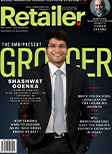
Agreeing to disagree with the maxim that good things come only in small packages, Ashok Gourish, Business Head, Bosch Packaging Technology, believes in offering various options for packaging for different product categories and in different sizes. In a conversation with Seema Seth, he talks about his packaging company, its products, services and much more…
SS: Tell us about your company?
AG: Packaging technology division of Bosch in India started in 1995 and the Goa operations commenced in 2007.
In India, the packaging technology division has the following business units:
- Packaging machinery which includes vertical and horizontal packaging machines
- Chocolates and confectionery wrapping machines
- Pharmaceutical filling and sealing machines
By 2013, the division will see an incremental increase in the production capacity of the plant and its employees. Bosch Packaging Technology India has sold packaging machines and process equipment in India to leading names in the pharmaceutical, confectionery and food processing industries.
At present, the operation in India designs, manufactures and markets form, fill and seal machines for flexible pouch packing and flow wrap machines for pillow packed candy applications and liquid pharmaceuticals products. The subsidiary in India brings the global expertise to manufacture form, fill and seal machines as well as flow wrap machines for the Indian market. To cater to the industry’s specific requirements in India, the company introduced a high speed continuous motion vertical form, fill and seal (VFFS) bagger to the market.
Bosch Packaging Technology India is ISO 9001:2008 certified. The company does not only provide far more than its well-proven machines, but also delivers complete concepts that satisfy all requirements based on modern technology – from ergonomic design right up to user friendliness. The modularly structured machine concepts of Bosch allow it to react quickly and flexibly to satisfy customer’s individual requirements. In addition, Bosch offers support in partnership by a comprehensive provision of services that is regarded best in class.
SS: What are your products?
AG: Bosch Packaging India manufactures the following machines:
- Vertical form fills and seal machines for packaging of free flowing solid product
- Horizontal form fills and seal machine manufacturing has recently started
- In the confectionery segment Bosch supplies the fastest candy wrapper from India
- Liquid filling and sealing machine are now being assembled in India for the
Pharmaceutical sector.
SS: Where is the manufacturing unit?
AG: We have our head office and manufacturing unit in Verna, Goa.
SS: Who are your target consumers? In which countries are your exporting?
AG: Our target customers are in the food, confectionery and pharmaceutical sectors.
Apart from selling the machines to the Indian market, we also export machines to the following countries:
Bangladesh , Nepal ,Sri Lanka ,South Africa, Middle East, UAE, North Africa, Kenya, Nigeria.
SS: What are your marketing and promotional strategies?
AG: We have a very dynamic marketing team in Bosch packaging India. We regularly participate in various exhibitions in India. Apart from this, we have started hosting in house shows for different applications. We increase our media presence by publishing technical articles and product reviews. Advertisements from Bosch also help increase our brand recognition.
SS: What is the USP of your products?
AG: Our products bear the stamp of Bosch that signifies that our products are more reliable, of the best quality and follow all safety standards. The machines are efficient, and have the latest inventions as a part of technology of the machine.
SS: Who are your competitors?
AG: We face competition from not only the global players, but also from the local machinery manufacturers. We respect the competition and upgrade ourselves to increase the market share.
SS: What services you give along with the product?
AG: From PAIV we support our customers in many ways for executing their projects. We offer turn key solutions including preparing a layout for their plants from processing to packaging. We support them on their utility requirements and positioning their utilities in such a way that their operating cost is reduced.
We carry out regular in house training programs for the maintenance and operational personnel of our customers.
SS: Tell us about the CSR of your company.
AG: In Bosch packaging India we have a enthusiastic group who call themselves PRERNA and are very active with the CSR activities in Goa. In 2011 Bosch is globally celebrating 125 years and this year apart from events focusing on associates, business, technology and innovation, Bosch will also focus on promoting education as part of its social responsibility commitments. In India, Bosch will work towards school adaptation, improvement of school infrastructure and distribution of free text books and stationery at schools across the nation.
SS: What kind of R&D are your undertaking?
AG: Every company wants a growth and desires for a bigger pie of the cake. Bosch is no exception. This can only be achieved by continuously upgrading the portfolio and offering new solutions for the customer. The industry is rapidly changing and customers are sending new requirements on a daily basis. We are keeping pace with the industry and upgrading the portfolio to meet the customer demand.
We plan to introduce new packaging technologies, latest innovations suited for the Indian market. Bosch India expands its portfolio with the horizontal form fill seal machines in food and non food sector). We would be providing total solutions including processing, primary packing and secondary packaging solutions. You can see our new market launches in next few exhibitions.
SS: What are your expansion plans?
AG: Bosch is consistently growing year after year in all sectors and same is the case with Bosch Packaging India. Talking about expansion plans, we have purchased 33000 sq metres of land in Verna Industrial Estate, Goa, where Bosch Packaging India will be having its own plant. The investment of 25 crores in the plant & machinery will further strengthen our future plans and leadership position in all the three business verticals, viz, pharma, confectionery & packaging machines.The plant will be ready by 2012.
At Bosch, we broaden our offerings based on the requirements of our customers and strive for continuous profitable growth.
Copyright © 2009 - 2024 Franchise India Holdings Ltd













